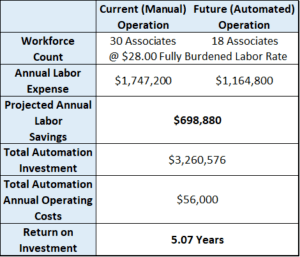Finding the best automation solution for your warehouse involves many variables, but a key factor is understanding the solution’s return on investment to determine if it is cost-effective or not. As companies embrace the era of intelligent technology, strategic budgeting becomes crucial for successfully implementing and maintaining automated warehouse systems.
Understanding the Need for Automation
Before diving into strategic budgeting, it’s imperative to recognize the driving forces behind warehouse automation. Increased demand for faster order fulfillment, error reduction, and the desire to optimize overall operational efficiency while maximizing labor productivity are among the primary reasons businesses turn to automation. By streamlining processes through technology integration, companies can enhance productivity, minimize errors, and ultimately improve customer satisfaction.
Assessing Current Operations

The first step in strategic budgeting for warehouse automation is conducting a comprehensive assessment of the existing warehouse operations. This includes analyzing current workflows, identifying bottlenecks, and understanding the specific pain points that automation can address. A thorough assessment provides valuable insights into the areas where automation can make a significant impact, allowing for targeted budget allocation.
Setting Clear Objectives
Establishing clear objectives is paramount to successfully budgeting for warehouse automation. Whether the goal is to increase order processing speed, reduce labor costs, or enhance order
accuracy, defining these objectives helps prioritize automation investments. Each objective should be measurable and aligned with the overall business strategy to ensure a return on investment is possible.
Cost-Benefit Analysis

Return On Investment Example
Conducting a detailed cost-benefit analysis is a critical component of strategic budgeting. This involves estimating the initial costs of implementing automation solutions, including equipment, software, and installation expenses. Understanding the impacts of long-term operating expenses should also be part of this process. Simultaneously, businesses must project the expected benefits, such as labor savings, increased throughput, and error reduction. A well-executed cost-benefit analysis aids decision-makers in determining the feasibility and potential return on investment for each automation initiative.
Prioritizing Investments
Not all warehouse processes require the same level of automation. Strategic budgeting involves prioritizing investments based on their impact on the overall operation. High-impact areas where automation can yield significant benefits should be allocated a larger portion of the budget. This prioritization ensures resources are directed toward initiatives aligning with the company’s overarching goals.
Adapting to Scalability
Warehouse automation should not be viewed as a one-time investment but rather as a scalable solution that can grow alongside the business. Strategic budgeting considers the scalability of automation systems, allowing for future expansions or modifications. This approach ensures that the initial investment lays the foundation for long-term success without the need for substantial reinvestment in the future.
Continuous Monitoring and Optimization
Investing in warehouse automation continues after the initial implementation. Continuous monitoring of automated processes is essential to identify areas for improvement and optimization. Allocating a portion of the budget for ongoing maintenance, software updates, and employee training ensures that the automated system remains efficient and aligned with evolving business needs.
By adopting a forward-thinking approach to budgeting, businesses can unlock the full potential of warehouse automation, achieving operational excellence while staying ahead in modern supply chain management.
Our team looks forward to evaluating your existing operations to show you the potential returns of implementing automation into your operations. Click here to get the process started today!

